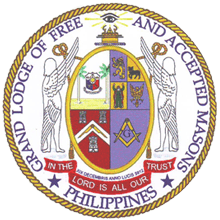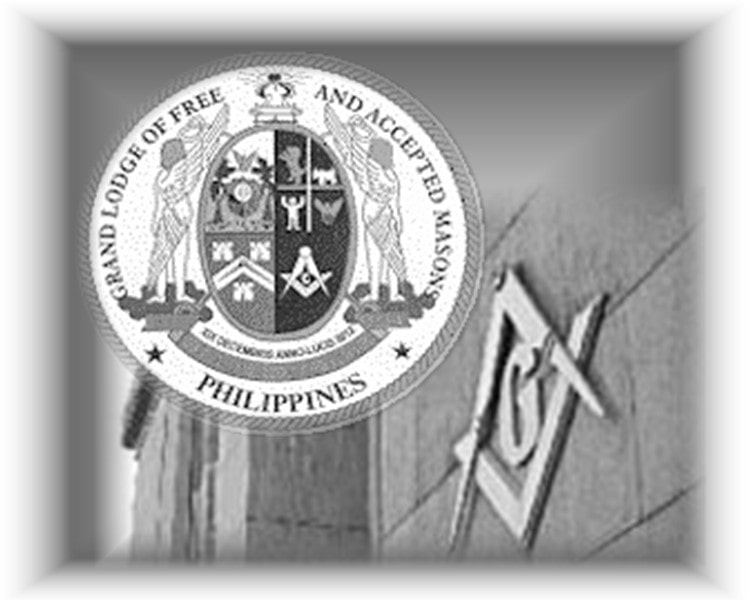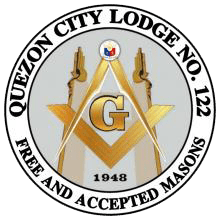Freemasonry in the Philippines
OFFICIAL WEBSITE OF
QUEZON CITY LODGE NO.122

Named after Quezon City where it is located. The creation of Quezon City was the consuming dream of President Manuel L. Quezon. He picked the site of the city and did the entire spade work leading to its establishment.
Written by VW Geminiano V. Galarosa, Jr., PDGL
(Dagohoy Lodge No. 84; Past Master of Quezon City Lodge No. 122)
The history of Philippine Masonry may be likened to the history of the first Grand Lodge. On the Feast of St. John the Baptist in 1717, four of the pre-existing Masonic lodges in Great Britain organized what became the first Grand Lodge of the world. On December 19, 1912, three lodges that were chartered under the Constitution of the Grand Lodge of California finally succeeded in establishing the Grand Lodge of Free and Accepted Masons of the Philippine Islands, the forerunner of what is now officially known as the Most Worshipful Grand Lodge of Free and Accepted Masons of the Philippines.
Worshipful Grand Lodge of Free and Accepted Masons of the Philippines.
Masonry existed in England long before the creation of the first Grand Lodge, so was Philippine Masonry already alive even before the formation of the Grand Lodge of the Philippine Islands. In 1856, for example, Primera Luz Filipina, the first Masonic lodge in the Philippines, was formed by Jose Malcampo y Monge, a naval captain who subsequently became Governor General of the Philippines.

Primera Luz was chartered by Gran OrienteLuisitano and admitted only Spaniards in its fold. Subsequently, three other lodges were established one after the other: the first by the Germans, the second by the British consul inNagtahan, and the third by the Spaniards in Pandacan.
Not only that, Dr, Serafin Quiazon, head of the National Historical Institute of the Republic of the Philippines, while researching in London on the British trade with the Philippines, stumbled upon a significant piece of historical data. Guissippe Garibaldi, that brilliant Italian revolutionary whom President Abraham Lincoln offered a command in the United States Army during the American Civil War, captained a vessel that anchored in Manila Bay sometime in the middle of the nineteenth century. There is little doubt that the tenets of the Craft landed with Garibaldi in the sandy beaches of the Philippine Islands during that period.
The Filipino Partiots Embrace the Tenets of Freemasonry
It was the influx of the students who pursued higher studies in Europe, among themMarcelo H. del Pilar from Bulacan, Graciano Lopez Jaena from Iloilo, the Luna brothers from Ilocos, Galicano Apacible from Batangas, Domingo Panganibanfrom Camarines Norte, Jose Alejandrino from Pampanga, Tomas Arejola fromCamarines Sur, Ariston Bautista from Manila, Julio Llorente from Cebu, and the country’s foremost hero, Jose Rizal from Laguna, that made a conglomeration of Masonic patriots from the entire archipelago. In 1886, some of them joined LodgeSolidaridad No. 53 in Barcelona, Spain, while others joined Lodge Revoluccion, and, exposed to the tenets of the fraternity, established local lodges upon their return to the islands. Nilad Lodge was formed first on January 6, 1891, and, in no time, several lodges mushroomed in Manila and its environs, even reaching as far as Zamboanga in the southern backdoor. By 1893, they had succeeded in establishing the Grand Regional Council under the leadership of Ambrocio Flores. Three years later, the Philippine Revolution conflagrated an armed rebellion that was initiated by theKatipunan led by Andres Bonifacio. Bonifacio’s organizational skills and the secret codes that he employed were said to have been copied from the Masonic secret rules and procedures. These ultimately led to the downfall of the nation’s conquistadors who for more than three centuries wielded the stick without dangling any carrot over the subjects of the entire archipelago.
It can be said, however, that Masonry during those tumultuous and rebellious years was in suspended animation. The “hawks,” among them Andres Bonifacio and EmilioAguinaldo, became Katipuneros; the “doves,” which included among others, JoseRizal, Numeriano Adriano and the thirteen martyrs of Cavite were herded in the dungeons and ultimately shot at Bagumbayan. A third group called the “chameleons” or balimbings, simply changed their coats and did what they thought best, be pliant as a bamboo and swing to the rhythm of nature, wherever the wind blows.
The Americans Enter the Political & Masonic Scenes …
Then came the American conquerors that hounded the self-proclaimed Philippine President Emilio Aguinaldo and his ragtag band to the boondocks. Many of these Philippine Masons, already sporting their avowed roles as “Rebolucionarios,” were at their wits’ end, eluding the pursuing Gringos. What the Filipinos did not realize was that these soldiers were led mostly by Masons: Generals Arthur MacArthur; John J. Pershing who was then but a captain, a Shriner and who answers to the monicker”Black Jack Pershing;” Harry Bandoltz; and James G. Harbord; the last two named generals later forming the forerunner of the Philippine Constabulary or the present-day Philippine National Police (PNP).
The Country as a Free-For-All Masonic Jurisdiction …
The surrender of General Aguinaldo effectively ended the armed insurrection against the Americans and also resulted in a field day for the different Grand Lodges andappendant bodies of the Masonic fraternity. Early to make their presence felt were the American Military Lodge led by the United States Volunteers from North Dakota, the Knights Templar, and the Prince Hall Grand Lodge of Missouri, a lodge composed of Negro soldiers from the United States. These were immediately followed by the Grand Lodge of California through the creation of what is called “The Sojourners Club” and thereafter was followed by creation of Manila Lodge No. 342, Cavite Lodge No. 350 andCorregidor Lodge No. 386
On the local front, first to reorganize was Grand Master Ambrocio Flores who attempted to establish the Filipino Grand Orient in 1899. This was followed by the GranOriente Espanol through the reactivation of Modestia Lodge No. 199, the Grand Orient of France that was introduced by Dr. Trinidad Pardo H. de Tavera, the Philippine Grand Orient that was established by Jose Utor y Fernandez, and the Grand Lodge of Scotland that established Lodge Perla de Oriente 1034 in Manila and Cebu Lodge No. 1106 in the Visayas. Gran Oriente de Espana also came into existence and so didGran Oriente Luisitano Unido, making the country a conglomeration of several Masonic disciplines and jurisdictions.
Furthermore, the Americans brought to the fore several appendant organizations, notably the Scottish Rite, the York Rite, the Mystic Shrine and the Order of the Eastern Star. Even the Chinese secret societies composed of Chinese Masons who claimed kinship with the worldwide fraternity entered the picture. All these complemented and co-existed with one another.
The Formulation of the Grand Lodge of the Phil. Islands …
Invariably, confusion ensued. The Americans kept membership in their lodges to themselves; the Filipinos clamored for recognition, until, finally, the three American lodges that were chartered under the constitution of the Grand Lodge of California sought dispensation from their Mother Grand Lodge to form their own and thus established in 1912 what came to be the Grand Lodge of the Philippine Islands. Their respective Lodge numbers were also changed and became Manila Lodge No. 1,Cavite Lodge No. 2 and Corregidor Lodge No. 3, respectively.

Masonry Silently Works by the Sidelines …
It is interesting to note that Masonry worked in mystic ways. Unknown to many, Generals Harry H. Bandholtz and Gary G. Harbord took Manuel Luis Quezon into their protective wings and gave him his political start in Tayabas by helping him get elected an Assemblyman. It was most reasonably because of his close association with the two that encouraged Quezon to join the Masonic fraternity by petitioning for membership at Sinukuan Lodge No. 273 in 1907. His appointment as Resident Commissioner in Washington would later serve as guiding light in his future Masonic endeavors when he was refused admission in a lodge in the United States on the ground that his lodge in the Philippines was clandestine. At about the same time that Quezon was initiated into the mysteries of Masonry, Rafael Palma petitioned for membership at Bagong Buhay Lodge 291 while Juan Sumulong joined a lodge of Gran Oriente de España and later became member of Bagumbayan Lodge No. 4 under the jurisdiction of the newly-formed Grand Lodge of the Philippine Islands; three illustrious Freemasons who were all admitted to the Philippine bar and would make their respective presence felt in the corridors of power of the American-guided government.
The Polarization of the Brethren into Two Main Bodies …
The existence of lodges under several jurisdictions became as confusing as would two amateur players playing chess with so many boisterous kibitzers watching the game on a chessboard. The California Lodges recognized the Scottish Lodges but did not accept brethren from the Filipino Lodges. The Scottish Lodges maintained relationship with both the American and Filipino lodges but completely ignored the black-skinned Prince Hall lodges. Until finally the Masonic field polarized into only two main bodies, the Grand Lodge of the Philippine Islands composed of the white-skinned Americans, and the Regional Grand Lodge which consists of the brown-skinned Indios of the land.
Merging into one Masonic Roof …
It is doubtful whether Masonry in the Philippines could have achieved easy unification and harmonious relationship without the combined talents of Governor Francis Burton Harrison and Manuel Luis Quezon. Harrison was appointed Governor General in the Philippines and had publicly acknowledged that he owed his appointment to Quezon. The Governor was raised to the sublime degree of Master Mason on July 11, 1916 and brought with him his pro-Filipino inclination to the Masonic world. It was therefore inevitable that the fusion gained headway on both sides and when the election for Grand Master was held for the first time under the fused bodies in 1917, the Americans who were easily outnumbered, were surprised to see MW William H. Taylor reelected during the first year of fusion. It was also the start of what would later amount to a Rigodon de Honor of electing a Grand Master, much like the checkered floor of King Solomon’s Temple; if it is white this year, then it should be brown next time. Una sin otra were the Spanish words for it.
Growth, Expansion, & the role of Filipino Masons …
The years that followed the unification registered impressive growth for the Craft. In four years time starting in 1918, thirty-eight lodges were established. The Filipinos that were elected Grand Masters, alternating with the Americans every two years, was led by Manuel L. Quezon. MW Quezon was followed by Rafael Palma, Quintin Paredes, Wenceslao Trinidad, Francisco Afan Delgado, Teodoro M. Kalaw and Vicente Carmona, in succession. These illustrious gentlemen were also quite active in the corridors of power. At this point and time, most of the notable political figures were Freemasons. It was therefore no wonder that Monsignor Michael O’Doherty wrote in his diary in 1917 shortly after his installation as Archbishop of Manila, “Masonry is a menace. Osmena, (the incumbent Speaker of the House) is the only government official of any standing who is not a Mason here in Manila.”
The Nation Gain Independence …
The 1935 Constitution led to the granting of the country’s Commonwealth status and ultimately her independence. This Philippine independence was gained largely through the efforts of Masons. No wonder, the names Manuel L. Quezon, Rafael Palma, Quintin Paredes and Manuel L. Roxas alternated in shuttling to and from the United States to lobby for the untangling of the country’s umbilical cord with the United States. When the election of the Constitutional Convention delegates were tallied, 42 out of 202, or 21 percent of the total, were Masons.
The War Years …
Wars always inflict destruction not only to the country and its people but more so to the Masonic fraternity whose tenets would not allow them to stay idle by the sidelines. Masonic records were destroyed and countless of its sons were either incarcerated or suffered heroic deaths. Topping the list is MW Jose Abad Santos who was executed by the Japanese government for non-cooperation. Grand Master John Robert McFie, RW Jose P. Guido, Deputy Grand Master and RW Antonio Ramos, Junior Grand Warden, also became casualties. So did many more of its sons.
Rebuilding From the Ashes …
It is a truism that after the storm is peace. Lodges were rehabilitated, new ones were added and, progressively, the tenets of the Craft were indelibly imprinted in the country’s history unnoticed by many as it vaulted through the 21st Century.
Freemasonry …
The sheer lack of drum-beaters within the Craft does not allow that the sterling qualities of members go unnoticed. A major factor that influence this situation is the generally subdued attitude of the members themselves. Except for the brethren who are in the know, the public does not realize that Freemasonry and its adherents always play important roles in the nation’s history.
The two EDSA revolutions have produced Freemasons from both sides of the political fence whose names, because of the lapse of time, will no longer be mentioned.
The Recent Political Turmoil- Results updated to March 1, 2007
But the political turmoil that rocked the country that was caused by the allegation that the nation’s president won through dubious means has shown several members of the Craft unflinchingly doing their duties on both sides of the political fence. Eight brothers whose sterling qualities are admirable may indirectly be mentioned.
At the other side …
A brother from Salug Valley No. 216 and the whistle blower who produced the tapes that rocked the entire country, a former Deputy Director of the National Bureau of Investigation, whose dedication to the cause he believed in is beyond compare. What happened to him, his whereabouts and the status of the cases filed against him are unknown.
A brother from Luzon No. 57-the Philippine Army’s Brigadier General who sacrificed his expected pension six days before retirement by honoring the Senate investigation on the alleged election irregularities in Mindanao and even subjected him to court martial for his heroic deed. A case was filed against him at the military tribunal but media has since been ominously silent on the status of the case.
From the Philippine National Police …
From Bontoc No.140-the Director of the PNP who walks the tight rope doing police functions to the best of his abilities, cognizant of the constitutional rights of his fraternal brothers at the other side that these are duly protected. He has since retired as PNP Chief and after retirement was appointed head of the National Irrigation Administration.
From. Pampanga No. 48- the Deputy General of the PNP for the National Capital Region who is in charge of the peace and order in the entire metropolis and whose ending statement when interviewed over the radio is invariably “May God bless us all always,” debunking the myth that Freemasons are Godless.
Word has it that he was recently appointed ambassador to Indonesia.
From Congress …
From Jacobo Zobel Memorial No. 202- The debonair Chairman of the Public Information Committee whose finesse and fair play at conducting the investigation is indeed admirable. His political fortunes still reverberating, it would be safe to guess that he is running for reelection on his seat at Congress.
From. Kutang Bato No. 110- The Chairman of the Justice Committee, who formerly was both Justice, and Public Works and Highways secretary, adeptly steered the proceedings exonerating the lady president from impeachment charges and thus eluded being thrown to the wolves at the upper branch of the Legislature called the Senate.
His present preoccupation is undermined but if his stint at Congress has not yet reached the final third term, may again present himself as a candidate for reelection in his home province.
At the Judiciary …
From Hiram Lodge No. 88- a past Grand Master and revered elder in the Fraternity whose appointment as the most eminent jurist of the judicial branch, being the most senior member at the bench was thought certain, was bypassed by the appointing authority using the political maneuver called revolving-door -policy. Although publicly admitting he was hurt, he accepted calmly the slings and arrows of outrageous fortune and promptly continued his work at the bench doubly aware that the All Seeing Eye never sleeps and that he will ultimately be vindicated by God Almighty.
On December, 2006, he was finally appointed Chief Justice of the Supreme Court thus vindicating his case and finally reached the apex of his illustrious career at the bench.
And finally, from the Executive Branch …
The Fraternity’s Past Grand Master, a member of Alfonso Lee Sin No. 158 whose indispensable duty as Secretary of Public Works and Highways require that he performs without fanfare at the sidelines and also to do the tasks and biddings that his superior dictates.
In February 2007, he was appointed Secretary of the Department of National Defense by the country’s president thus pole vaulting from the Department of Public Works and Highways to the more awesome task of defending the nation’s citizenry.
This brief history, first written in 2002, updated in 2006 and again revised to cover significant events to March 2007, can never end for as the earth rotates upon its own axis each day, worthy brothers also etch out daily their own accomplishments that bring honor and glory to this ancient and honorable Fraternity.
Sources:
Votaries of Honor by MW Reynold S. Fajardo, PGM
The July-August 1982 issue of the Cabletow
The March-April 1988 issue of the Cabletow
Updated March 3, 2007
